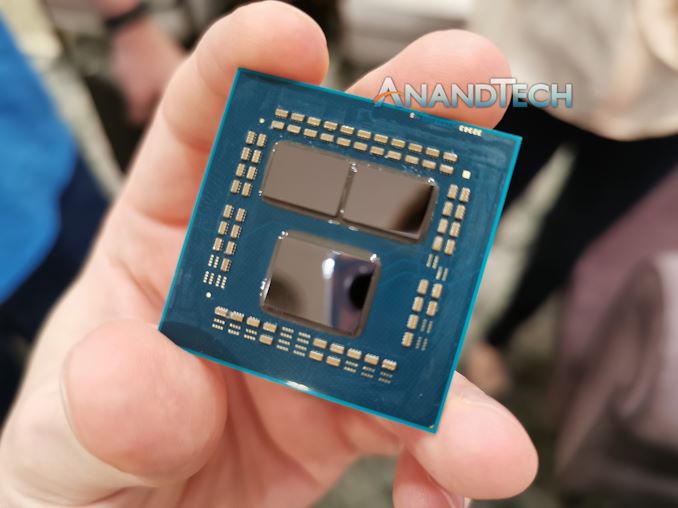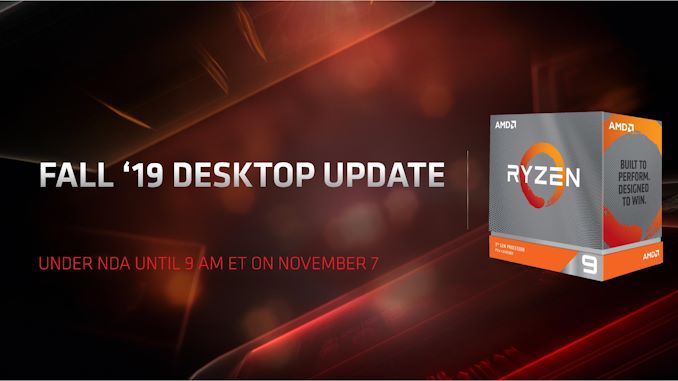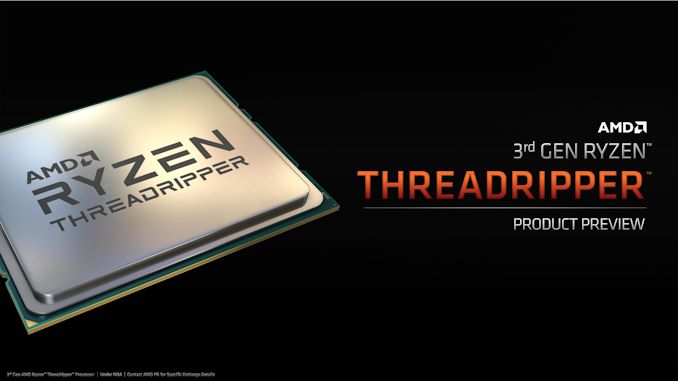AMD Q4: 16-core Ryzen 9 3950X, Threadripper Up To 32-Core 3970X, Coming November 25th
by Dr. Ian Cutress on November 7, 2019 9:00 AM EST
AMD is set to close out the year on a high note. As promised, the company will be delivering its latest 16-core Ryzen 9 3950X processor, built with two 7nm TSMC chiplets, to the consumer platform for $749. Not only this, but AMD today has lifted the covers on its next generation Threadripper platform, which includes Zen 2-based chiplets, a new socket, and an astounding 4x increase in CPU-to-chipset bandwidth.
This year AMD is presenting its ‘Fall 2019 Desktop Update’, covering the new products for the holiday season. Q4 is historically a good target for increased consumer sales, as long as the products hit the right price point and are available in volume for the peak shopping periods. We’ve been waiting mercilessly for more details about the crème-de-la-crème of what AMD has to offer with its 7nm product portfolio for both mainstream Ryzen desktop processors, but also the creator and workstation focused 3rd Gen Threadripper. After continuously requesting information from CEO Lisa Su since the middle of the year, AMD is lifting the lid on the product details, pricing, and launch dates.
The short version of today’s announcement revolves around several parts, in completely different markets.
- The Ryzen 9 3950X 16-core CPU for desktops
- Ryzen Threadripper 3rd Gen Family: Starting with the 24-core 3960X and 32-core 3970X
- New TRX40 motherboards for the new Threadripper Processors
- A new $49 Athlon 3000G for the entry level market
All of this hardware is set to come to market through the month of November at the following dates:
- Ryzen 9 3950X: Retail on November 25
- TR 3960X and TR 3970X on November 25th
- TRX40 motherboards on November 25th
- Athlon 3000G on November 19th
One key takeaway from today’s announcements is how AMD is moving the traditional desktop and high-end desktop markets. When CEO Dr. Lisa Su was asked earlier this year what will happen to Threadripper as the mainstream Ryzen family moves ‘up’ in performance, her response was that ‘Threadripper will move up-up’. To that effect, we are seeing AMD’s delineation between mainstream desktop and high-end desktop move up to between 16-core and 24-core, with room at the top for more cores if AMD wants to go that way.

Our Group Interview with Dr. Lisa Su at Computex 2019
This new hardware is also breaking new records for enthusiast CPU TDP values, as well as representing new ground on the latest 7nm process technology now available to the wider market. Details about pricing, TDP, AMD’s strategy, AMD’s performance numbers, TRX40 chipset information, and analysis of the announcements are all inside.












171 Comments
View All Comments
cfenton - Thursday, November 7, 2019 - link
Almost nothing. These things are for work. A reasonably fast quad core (anything Ivy Bridge or newer, really) is fine for almost any casual programs. Going up to eight cores makes sense for gaming since the new consoles will be eight core.TheinsanegamerN - Thursday, November 7, 2019 - link
The consoles have been 8 core since 2013 dude. PS4 and xbone are 8 core. 8 slow cores, which should have prompted swift acceleration of multi threaded game engines.Yet here we are.
milkywayer - Thursday, November 7, 2019 - link
Half of this console generation Intel was in the lead and they kept milking the core count. Until 3,4 years ago they were selling dual core cpu as i7 on mobile. It wasn't until AMD came up and basically showered everyone with 4 and 6 core cpus for half the price is when Intel dropped the BS and started offering real 6 core cpus in the lower tier consumer market and 4 core real 4 core cpus in mobile etc. I blame only Intel.cfenton - Thursday, November 7, 2019 - link
And we saw slow progress toward multi-threaded games throughout the generation. There are way more games today that can take advantage of 4+ cores than there were in 2013. It takes time to adapt game engines and not every kind of game will even benefit from more cores. All I'm suggesting is that if you play games you have some reason to go beyond four cores.evernessince - Thursday, November 7, 2019 - link
Consoles were based off jaguar, which really had 8 half cores that shared execution units. So really, 4 cores.scineram - Friday, November 8, 2019 - link
No.Spunjji - Friday, November 8, 2019 - link
You're confusing Jaguar for Bulldozer.Jaguar uses complete cores, albeit "small" ones in terms of area - in design and performance terms they're somewhere between the old K8 Athlon 64 and K10 Athlon II processors.
I think the confusion comes in because the console implementation of Jaguar has 8 cores split across 2 "modules" which is the same terminology used for 'dozer, but referring to a different thing:
Bulldozer module = 2 cores with shared FP resources
Jaguar module = 4 independent cores, like a CCX in Zen
Zizy - Friday, November 8, 2019 - link
8 cores at 1.6GHz (PS4 as the slowest) is at best the same as 4 cores at 3.2 GHz, assuming everything else equal and perfect MT. Plus those cat cores were essentially half as capable as the current stuff, normalized by clock. Therefore, consoles have about the same as 2 proper desktop cores - the lowest end CPUs you can buy.Anyway, there are many games that use more than 4 cores these days. Especially stuff coming out now when also Intel started offering more cores and AMD having competitive if not superior chips.
nevcairiel - Thursday, November 7, 2019 - link
Casual everyday users absolutely do not need such CPUs.DigitalFreak - Thursday, November 7, 2019 - link
Exactly right. Core count is the new Mhz race for the uninformed.